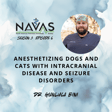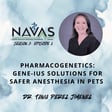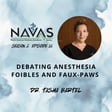
Dr. Melina Zimmerman on Postoperative Pain Control at Home - Part 2
Are you having a BRAT summer, because we sure are here on the NAVAS podcast! By BRAT, we mean Best Remedies for Analgesic Therapy! We’re excited to continue our discussion on post-operative pain control for dogs and cats. If you haven’t listened to part one of this conversation, please go back and listen before diving into this episode. We’re going to finish up our conversation on surgical pain management by discussing the nuances of NSAID use in cats, confronting some controversial opinions on Gabapentin, rave about local anesthetic agents, and introduce some pharmacologic and non-pharmacological therapies to help tackle acute pain for our patients. Joining us again is Dr. Melina Zimmerman, veterinary anesthesiologist and owner of The Doggy Gym, where she provides pain management therapies for all kinds of species. Pain management is so much more than “set and forget”, and we hope to convince you of that right here on the NAVAS podcast.
References are made to the following resources in the episode:
Our previous short episode on Nocita with Dr. Tammy Grubb.
2022 ISFM consensus guidelines on managing acute pain in cats that has been endorsed by the American Association of Feline Practitioners (AAFP):
2024 ISFM & AAPF consensus guidelines on long-term NSAID use in cats
Buprenorphine as an additive agent with bupivacaine for certain dental blocks in dogs
If you like what you hear, we have a couple of favors to ask of you:
Become a member of NAVAS for access to more anesthesia and analgesia educational and RACE-approved CE content.
Spread the word. Share our podcast on your socials or a discussion forum. That would really help us achieve our mission: Reduce mortality and morbidity in veterinary patients undergoing sedation, anesthesia, and analgesia through high-quality, peer-reviewed education.
As a reminder, the ACVAA Annual Meeting is happening in Denver, CO from September 25-27 later this year. Registration rates are discounted for NAVAS members. We hope to see you there! Sign up today!
Thank you to our sponsor, Dechra - learn more about the pharmaceutical products Dechra has to offer veterinary professionals, such as Zenalpha.
If you have questions about this episode or want to suggest topics for future episodes, reach out to the producers at education@mynavas.org.
All opinions stated by the host and their guests are theirs alone and do not represent the thoughts or opinions of any corporation, university, or other business or governmental entity.











